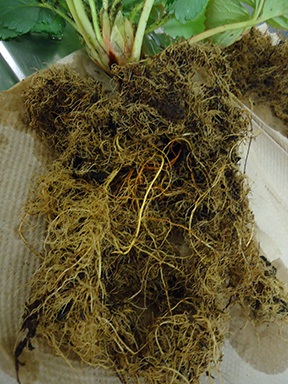A report of substrate trials on day-neutral strawberries
Learn research results of substrate trials using different substrate and irrigation/fertigation methods on day-neutral strawberries.
A set of substrate trials was established at the Simcoe Research Station to compare different substrate and irrigation/fertigation methods under the Industry-led Research and Development Stream of the Agri-Innovation Program Federal Growing Forward 2 initiative. In the first three trials, different substrates were examined. One of the substrates, referred to Simcoe substrate, has been historically used at the research station to grow strawberries. Other substrates in the trial were provided by the Fafard Company. Field sand was also used in the first trial. The Simcoe substrate was made with equal volumes of peat, turface, sand and perlite. All of the Fafard substrates were better than Simcoe substrate or field sand and were used in subsequent trials. Among Fafard mixes, plants growing in G10 had fibrous root growth and higher vegetative growth. However, if this substrate dries out, it takes a lot of time to absorb water again and may create inconvenience when used in pot culture. Fafard mixes G6, G5 and N7 are performing equally well. N7 has been designed for nurseries and has big chunks of bark. It absorbs water easily and does not dry out as much as G10. When the physical properties of these substrates are compared, G10 has the highest aeration score. The higher drainage in G10 can contribute to the higher growth rate of strawberries in this substrate. All Fafard mixes have a medium to high capacity to retain water in their structure, which is critical for strawberry plants.
A few genotypes have been tested during these substrate trials. Both Seascape and Albion were used during early trials, however, only Albion is presently being used. An inbred line of strawberries with a low growth rate will also be used to highlight the potential of different mixes for a slow growth genotype and to develop a protocol for substrate trial of our inbred lines for our breeding program.
Early attempts to use fertilizer injectors to fertigate the strawberries in the research trials were unsuccessful, due to the low flow rate of the drip irrigation system which did not initiate the injectors. In the last trial, fertilizer pump was used to pump the nutrient solutions into the irrigation system. Two nutrient solutions with EC (Electrical Conductivity) of 1.5 and 2 dSm-1 were used. The system is working very well now. During the winter, halogen lamps were used to provide extra light for the plants inside the greenhouse, however plants were still elongated due to low light conditions. With increasing the day length and light intensity the growth will increase, elongation will cease and flower clusters will produce fruits.

Healthy fibrous roots in a commercial substrate